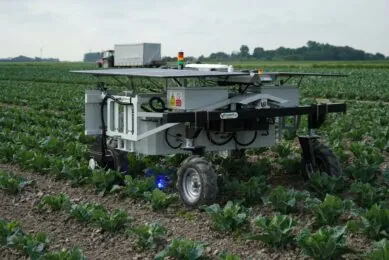The new TRAXX vineyard robot: a surprising first feedback

Wine grower Stéphane Dubreuil shares his experience after the first 100 hours with his TRAXX robot. He likes the simplicity and its remarkable fuel efficiency, but also sheds light on some challenges such as software glitches and the quest for reliable autonomy.
TRAXX is the latest robotic vineyard straddler to hit the market. Launched in 2019, Exxact robotics is the smart farming applications branch of the Exel group, which already markets straddle tractors under the Tecnoma brand. While more than 150 electric vineyard straddlers have already been sold, Exxact Robotics started the commercialisation phase of its thermal robot in 2023 and already has five machines in operation. Future Farming visited Stéphane DUBREUIL, a French winegrower and the first customer of this machine, to find out how it performed in the field.
The robot is equipped with a 56-hp diesel engine, housed in a light, compact vehicle weighing 1,600 kg and with a 1.20 m track. The engine drives a hydraulic pump, as the transmission is hydraulic and drives the wheels, as well as controlling the tools. The tool holder, which is conventional, offers the flexibility of attaching various tools available on the market. The robot is far more energy-efficient than a conventional straddle harvester, as Stéphane found out when he went from using 8 litres of fuel per hour to just 2.5 litres per hour with the robot.
One of the major advantages over an electric straddler is the simplicity, reliability, and cost-effectiveness of its components. In terms of use, there’s no need to recharge it at the farm every day since the machine has 15 to 20 hours of autonomy. And, according to Stéphane, working with a machine like Traxx is more reassuring because farmers are used to this system and are in a better position to repair it if necessary.
Text continues below picture

A robot at a highly attractive price
The basic cost of the robot is € 150,000, with the expectation of Stéphane benefiting from € 52,000 in grants from the PCAE subsidy (Farm competitiveness and adaptation plan). This overall price also includes support and training for the machine, as well as coverage of eight hectares for surveying. In comparison with market prices, the robot is as competitive as a conventional straddle carrier, and still € 50,000 less expensive than an electric robot. In the first year, technical support and SIM+RTK subscription are included in the package, while subsequent years of “Traxx Premium” with support and subscription are priced at € 4,000 per year.
Text continues below picture

A promising first season
The robot was introduced to the farm in June, right in the middle of the tillage season. After three months of use, the robot has accumulated 110 hours of work and has tilled six hectares. The tools assembly is homemade and includes weeding blades to work under the rows of vines, and a set of disks and tines to work a half-row on each side. The robot works at a speed of 2.7 to 3 km/h, but the winegrower feels that it’s still too early to get global productivity feedback.
Getting to grips with the machine proved easy. The training provided by the manufacturer was “sufficient to feel at ease with the machine.” The robot is equipped with a phone application to plan and monitor work, a remote control to move it, and controls on the machine to start it up. The farmer uses a car-carrier trailer attached to a tractor to transport the machine to his remote plots, although he can also move it manually in the plots around the vineyard.
Text continues below video
Reliable autonomy
As is to be expected with any new equipment in its early marketing phase, reliability problems have been encountered, especially on the software side. For example, at the time of our visit, a rear bumper had broken a few days earlier, and lifting the tools required human assistance. For the time being, the software is what’s preventing him from getting the machine to work even harder, but the farmer is confident, since his collaboration is proving very fruitful with regular software updates.
When it comes to repairs, the responsibilities are clear: the dealer takes care of the hardware part and its maintenance, while the manufacturer focuses on the software and its updates, which must be done on site.
As far as the machine’s profitability is concerned, it is unfortunately not possible yet to let it operate autonomously. Stéphane therefore must perform other tasks at the same time, with a tractor or not. However, as soon as regulations and the reliability of the machine’s software allow, he intends to make a quick return on his investment, as he declares, “I hope to be profitable before five years.”
Text continues below picture

Join 17,000+ subscribers
Subscribe to our newsletter to stay updated about all the need-to-know content in the agricultural sector, two times a week.



